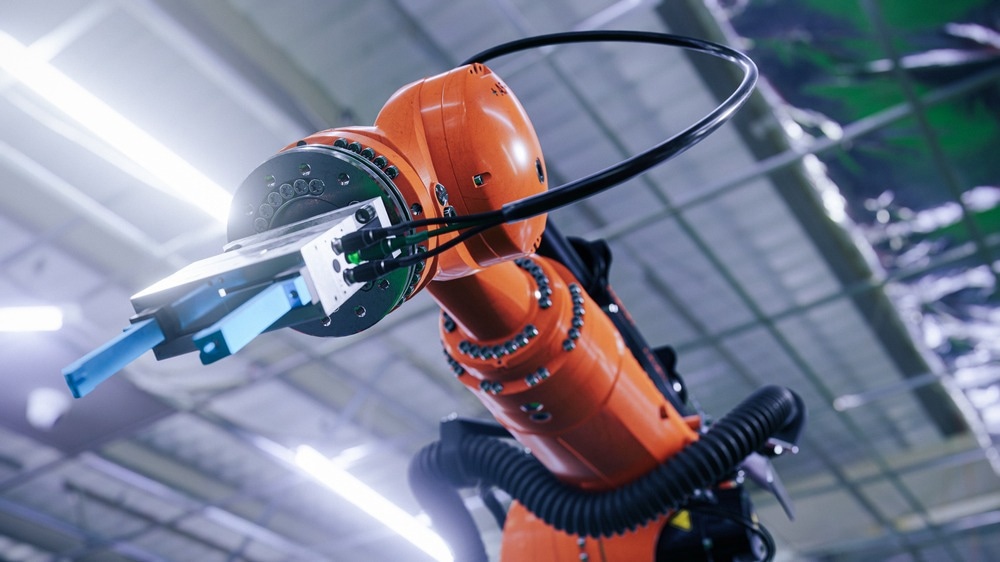The prevalence of robots in industries such as manufacturing, healthcare, and agriculture has risen sharply in recent years. As these robots become more advanced, the components they utilize must withstand the arduous demands of their tasks. Heat treatment techniques solve this challenge by significantly improving the durability and longevity of robot components.

Image Credit: C SCREEN/Shutterstock.com
The Art of Designing Robot Parts for Optimal Strength
The art of designing robot parts for optimal strength is critical to ensuring their efficiency and longevity. The process involves a combination of engineering principles, materials science, and computer-aided design techniques. The primary objective is to create parts that can withstand the loads and stresses they will encounter during their lifetime.
The first step in designing robot parts is to identify the loads and stresses acting on the part. These loads include tension, compression, bending, torsion, and shear. The designer must also consider the part's material properties, including its strength, stiffness, and toughness. Once the designer understands the loads and stresses the part will encounter, they can optimize its shape and size to maximize strength and minimize weight.
One common approach to designing robot parts is to use topology optimization. This technique uses algorithms to generate a design that maximizes the part's strength while minimizing its weight. Topology optimization allows designers to explore a vast design space quickly and efficiently, producing optimized parts for their intended use.
A critical consideration in designing robot parts is the manufacturing process. The designer must select a manufacturing method that can produce the part with the required strength and accuracy while minimizing production time and cost. Standard manufacturing methods for robot parts include CNC machining, 3D printing, and injection molding.
Treatment Methods for Robot Components
Heat treatment is a critical process in the manufacturing of robot components. This process involves heating the component to a specific temperature and then cooling it rapidly to alter its physical and mechanical properties.
The science behind heat treatment methods involves understanding the changes that occur at the atomic level during the heating and cooling process. Heating the component causes the atoms to vibrate more rapidly, which can cause dislocations in the crystal structure. Rapid cooling freezes these dislocations in place, altering the component's microstructure and improving its mechanical properties.
Throughout the years, metallurgists have developed various methods and, to this day, continue to work toward enhancing the outcomes and cost-effectiveness of these processes.
One of the most common heat treatment methods for robot components is quenching.
Quenching involves heating the component to a high temperature and then rapidly cooling it in a liquid such as water or oil. Quenching alters the microstructure of the component, increasing its strength and hardness. The speed of cooling, as well as the temperature and duration of the heating, can be adjusted to achieve the desired properties.
Tempering, which involves heating the component to a lower temperature than quenching and cooling it slowly, is another standard heat treatment method. This process relieves any internal stresses that may have developed during quenching and improves the toughness of the component.
The Benefits of Using Advanced Heat Treatment
Advanced heat treatment techniques have become increasingly popular in manufacturing robots due to their numerous benefits.
One of the main advantages is the improved strength and durability of robot components, leading to a longer service life and reduced maintenance costs. Heat-treated components are better equipped to handle the stresses and strains of repetitive motion, thus reducing the likelihood of failure. Heat treatment also increases resistance to wear and fatigue, allowing robots to perform more demanding tasks without breaking down.
Heat treatment allows for greater design flexibility to optimize the properties of a wide range of materials, making it possible to create lightweight and robust components. This flexibility also enables manufacturers to create customized components that meet specific performance requirements.
Heat treatment eliminates defects and improves material homogeneity, leading to higher-quality products. By reducing defects and improving consistency, manufacturers can reduce the risk of product failure and improve overall reliability.
Innovative Heat Treatment for Stronger Components
As robotics technology continues to evolve, so will the techniques used to manufacture robot components. One promising area of research is the development of innovative heat treatment techniques that can further improve the strength and durability of robot parts.
One such technique is laser surface treatment, which involves using a high-energy laser beam to melt and re-solidify the surface of a material. The laser beam can create a thin layer of hardened material that is highly resistant to wear and fatigue.
Ion implantation is another heat treatment technique for the future. This process involves bombarding a material's surface with high-energy ions to alter its properties. The bombardment of ions can create a surface layer that is highly wear-resistant and has improved fatigue strength.
Conclusion
In conclusion, heat treatment techniques are critical in designing and manufacturing robot components. Manufacturers can produce more durable, reliable, and efficient robots by understanding the art and science of designing robot parts for optimal strength and using advanced heat treatment techniques.
As robotics technology advances, innovative heat treatment techniques will likely play an increasingly important role in ensuring the success of these complex machines.
References and Further Reading
Zimmerman, D. (2023). Heat Treating Processes: A Glossary. [Online] Machine Design. Available at: https://www.machinedesign.com/materials/article/21832107/heat-treating-processes-a-glossary.
Velling, A. (2020). What Is Heat Treatment? Methods & Benefits. [Online] Factory. Available at: https://fractory.com/heat-treatment-methods.
ThemoFusion (2020). The Key Benefits of Heat Treating Your Metals. [Online] Thermo-Fusion. Available at: https://thermo-fusion.com/key-benefits-of-heat-treating-metals.
Malas, A. (2017). Extending Performance. [Online] Thermal Processing. Available at: https://thermalprocessing.com/extending-performance.
Disclaimer: The views expressed here are those of the author expressed in their private capacity and do not necessarily represent the views of AZoM.com Limited T/A AZoNetwork the owner and operator of this website. This disclaimer forms part of the Terms and conditions of use of this website.